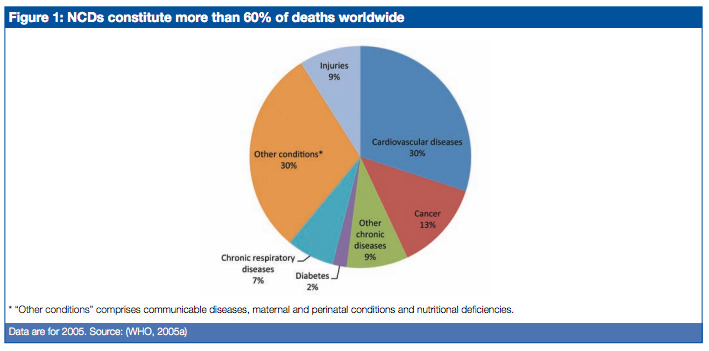Non-Communicable Diseases: Difference between revisions
Evan Thomas (talk | contribs) mNo edit summary |
Evan Thomas (talk | contribs) mNo edit summary |
||
| Line 72: | Line 72: | ||
<references /> | <references /> | ||
[[Category:Oncology | [[Category:Global_Health]] [[Category:Oncology]] [[Category:Cardiopulmonary]] [[Category:Cardiovascular Disease]] [[Category:Metabolic/Endocrine]] | ||
Revision as of 18:22, 5 November 2016
Original Editors - Rachael Lowe
Top Contributors - Admin, Kim Jackson, Tarina van der Stockt, Evan Thomas, Naomi O'Reilly, Lucinda hampton, Tony Lowe, George Prudden, Vidya Acharya, Rucha Gadgil, Robin Tacchetti and 127.0.0.1
Introduction[edit | edit source]
NCDs are collectively responsible for almost 70% of all deaths worldwide. Almost three quarters of all NCD deaths, and 82% of the 16 million people who died prematurely, or before reaching 70 years of age, occur in low- and middle-income countries.[1]. NCDs also account for 48% of the healthy life years lost (Disability Adjusted Life Years–DALYs) worldwide (versus 40% for communicable diseases, maternal and perinatal conditions and nutritional deficiencies, and 1% for injuries).[2]
What are NCDs[edit | edit source]
Non-communicable diseases are a diverse group of chronic diseases that are not communicable, meaning you can't catch them from another person. They are defined as diseases of long duration, generally slow progression and they are the major cause of adult mortality and morbidity worldwide[3]. Non-communicable diseases are identified by WHO as “Group II Diseases,” a category that aggregates (based on ICD-10 code) the following conditions/causes of death: Malignant neoplasms, other neoplasms, diabetes mellitus, endocrine disorders, neuropsychiatric conditions, sense organ diseases, cardiovascular diseases, respiratory diseases (e.g. COPD, asthma, other), digestive diseases, genitourinary diseases, skin diseases, musculoskeletal diseases (e.g. rheumatoid arthritis), congenital anomalies (e.g. cleft palate, down syndrome), and oral conditions (e.g. dental caries). These are distinguished from Group I diseases (communicable, maternal, perinatal and nutritional conditions) and Group III diseases (unintentional and intentional injuries)[2].
Four main diseases are generally considered to be dominant in NCD mortality and morbidity: cardiovascular diseases (including heart disease and stroke), diabetes, cancer and chronic respiratory diseases (including chronic obstructive pulmonary disease and asthma):
In addition to these 4 main diseases, mental disorders (including unipolar depressive disorder, alcohol use disorders and schizophrenia) are considered to be major contributors to the economic losses stemming from NCDs[2]:
NCD risk factors[edit | edit source]
These disease groups are linked by common risk factors:
- social determinants of health (this is the environment in which we are born, live and grow and the opportunities we are given in those environments)
- tobacco
- alcohol
- poor nutrition
- physical inactivity
Non-modifiable risk factors refer to characteristics that cannot be changed by an individual (or the environment) and include age, sex, and genetic make-up. Although they cannot be the primary targets of interventions, they remain important factors since they affect and partly determine the effectiveness of many prevention and treatment approaches.
Modifiable risk factors refer to characteristics that societies or individuals can change to improve health outcomes. WHO typically refers to four major ones for NCDs: poor diet, physical inactivity, tobacco use, and harmful alcohol use.
| Global Burden of disease - the rise of NCDs[4] | Busting the NCD myths[5] |
Role of Physiotherapy in NCDs[edit | edit source]
Physiotherapists specialise in human movement, physical activity, promoting health, fitness, and wellness. They identify physical impairments, limitations, and disabilities that prevent people from being as active and independent as they might be, and then they find ways of overcoming them. The profession of physiotherapy helps millions of people every year to prevent non-communicable diseases and their risk factors – most importantly obesity. Through targetted rehabilitation methods they also manage the effects of NCDs to optimise health when they are present.
The World Health Organization points out that physical inactivity is one of the leading risk factors for global mortality, causing 3.2 million deaths annually, and that physical activity can reduce non-communicable diseases, it is clear that the physiotherapy profession has a major part to play.
People with chronic health problems can improve their health by learning how to increase physical activity levels and exercise safely under the guidance and instruction of physiotherapists. Activity has to be introduced carefully if a person is overweight, unfit, older, or has a chronic disease. Physiotherapists do this by examining the person, recommending exercises that are safe and appropriate for them, and educating them about how to look for signs of trouble. This makes them the ideal professionals to prescribe physical activity and exercise programmes for non-communicable diseases.
Physiotherapy doesn’t just mean more healthy people, but more productive people who can contribute to countries’ economies. Their services are provided in an atmosphere of trust and respect for human dignity and underpinned by sound clinical reasoning and scientific evidence.The message is clear: physiotherapists are the movement, physical activity, and exercise experts and a resource in the battle against non-communicable disease that should never be overlooked.
Resources[edit | edit source]
WHO Non-Communicable Disease: Country Profile 2011
The World Economic Forum and the Harvard School of Public Health: The Global Economic Burden of Non-communicable Diseases.
Prevention and control of NCDs: Guidelines for primary health care in low-resource settings
References[edit | edit source]
- ↑ WHO. Noncommunicable diseases and their risk factors http://www.who.int/ncds/en/ accessed 15 July 2016
- ↑ 2.0 2.1 2.2 Bloom, D.E., Cafiero, E.T., Jané-Llopis, E., Abrahams-Gessel, S., Bloom, L.R., Fathima, S., Feigl, A.B., Gaziano, T., Mowafi, M., Pandya, A., Prettner, K., Rosenberg, L., Seligman, B., Stein, A.Z., &amp;amp;amp;amp;amp;amp; Weinstein, C. (2011). The Global Economic Burden of Noncommunicable Diseases. Geneva: World Economic Forum
- ↑ World Health Organization. (WHO 2005a). Preventing chronic diseases: a vital investment. WHO global report. Geneva: World Health Organization.
- ↑ Dr Alessandro R Demaio. The Global Burden of Disease - The Rise of NCDs. Accessed at fckLR https://www.youtube.com/watch?v=yAHJ2DWpe94 on 15 July 2016
- ↑ Dr Alessandro R Demaio. NCDFree- Myth busting NCDs. Accessed at fckLR https://www.youtube.com/watch?v=jTe8gnsHQ-Q on 15 July 2016







